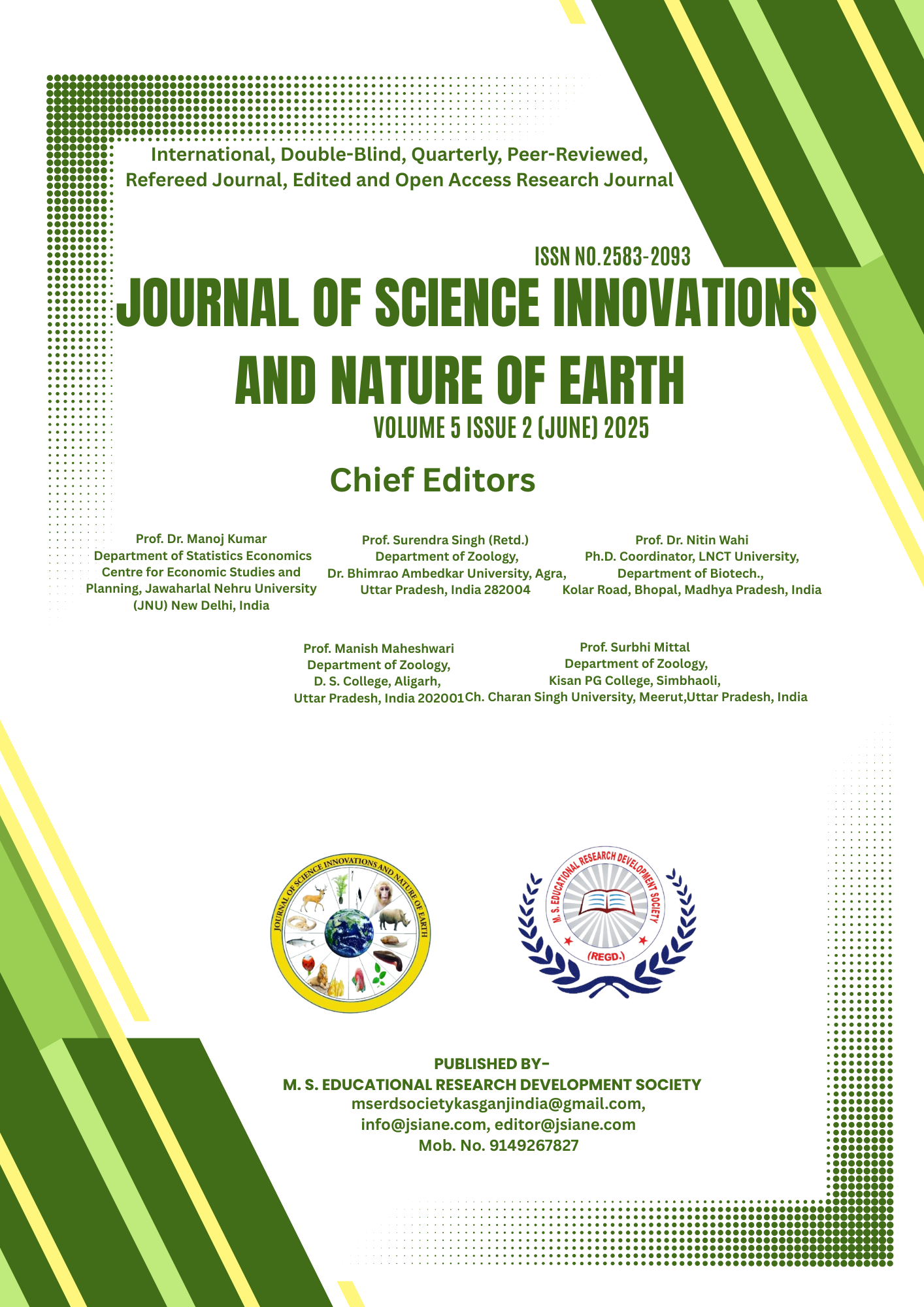Antibiotic Resistance Profile of Endophytic Bacteria of Leptadenia pyrotechnica Root: A Study from Alwar Region
DOI:
https://doi.org/10.59436/jsiane.415.2583-2093Keywords:
Antibiotic resistance, Leptadenia pyrotechnica, Endophytic bacteria, Antibiotic susceptibility, Plant extractsAbstract
Antibiotic resistance is a developing issue because it makes infections more difficult to treat, which increases the risk of death, lengthens sickness duration, and raises medical expenses, particularly when the bacteria causing the infection is resistant to numerous medications. In present study, we examined antibiotic resistance profile of endophytic bacteria from the roots of the Indian desert shrub Leptadenia pyrotechnica. This plant is well-known for both its capacity to improve the environment in arid regions and its health advantages. Twelve bacterial samples taken from the roots of the plant were tested against a variety of antibiotics, such as azithromycin, ciprofloxacin, and tetracycline. The findings demonstrated that the bacteria were susceptible to the antibiotics ciprofloxacin and gatifloxacin, which may be effective; however, the bacteria were resistant to other antibiotics, such as ampicillin, ceftriaxone, and azithromycin, indicating the need for novel treatments, including the use of plant-based compounds.
References
Almagboul, A. Z., Bashir, A. K., Farouk, A., & Salih, A. K. M. (1985). Antimicrobial activity of certain Sudanese plants used in folkloric medicine. Screening for antibacterial activity (IV). 331-335.
Artizzu, N., Bonsignore, L., Cottiglia, F., & Loy, G. (1996). Studies on the diuretic and antimicrobial activity of Cynodon dactylon essential oil. 174-176.
Bulgarelli, D., Schlaeppi, K., Spaepen, S., Van Themaat, E. V. L., & Schulze-Lefert, P. (2013). Structure and functions of the bacterial microbiota of plants. Annual review of plant biology, 64(1), 807-838.
Burdak, L. R. (1982). Recent advances in desert afforestation. 56.
Compant, S., Clément, C., & Sessitsch, A. (2010). Plant growth-promoting bacteria in the rhizo-and endosphere of plants: their role, colonization, mechanisms involved and prospects for utilization. Soil Biology and Biochemistry, 42(5), 669-678.
El-Fitiany, R. A., & Khasawneh, M. A. (2023). Leptadenia pyrotechnica (Forsk.) Decne: from edibility to drug discovery (a comprehensive review). Food Reviews International, 39(9), 6834-6886.
Gouda, S., Das, G., Sen, S. K., Shin, H. S., & Patra, J. K. (2016). Endophytes: a treasure house of bioactive compounds of medicinal importance. Frontiers in microbiology, 7, 1538.
Hardoim, P. R., van Overbeek, L. S., & van Elsas, J. D. (2008). Properties of bacterial endophytes and their proposed role in plant growth. Trends in microbiology, 16(10), 463-471.
Hou, M., Zhu, J., Leng, C., Huang, X., Yang, M., Yin, Y., ... & Chen, J. (2025). Composition and Biodiversity of Culturable Endophytic Fungi in the Roots of Alpine Medicinal Plants in Xinjiang, China. Journal of Fungi, 11(2), 113.
Ikram, M., & Inamul-Haq, I. H. (1984). Screening of medicinal plants for antimicrobial activities. III. 62-64.
Izzo, A. A., Di Carlo, G., Biscardi, D., De Fusco, R., Mascolo, N., Borrelli, F., ... & Autore, G. (1995). Biological screening of Italian medicinal plants for antibacterial activity. Phytotherapy research, 9(4), 281-286.
Kubo, I., Muroi, H., Himejima, M., Yamagiwa, Y., Mera, H., Tokushima, K., ... & Kamikawa, T. (1993). Structure-antibacterial activity relationships of anacardic acids. Journal of Agricultural and Food Chemistry, 41(6), 1016-1019.
Kumar, V., & Jain, M. (2015). The CRISPR–Cas system for plant genome editing: advances and opportunities. Journal of experimental botany, 66(1), 47-57.
Li, J., Qin, S., Xu, J., Xiong, J., Wu, C., Bai, Y.,. & Yu, H. (2016). Randomized, double-blind, placebo-controlled phase III trial of apatinib in patients with chemotherapy-refractory advanced or metastatic adenocarcinoma of the stomach or gastroesophageal junction. Journal of Clinical Oncology, 34(13), 1448-1454.
Lowe, H. I., Daley, D. K., Lindo, J., Davis, C., Rainford, L., Hartley, S. A., & Thoms-Rodriguez, C. (2017). The antibacterial and antifungal analysis of crude extracts from the leaves and bark of Pimenta species found in Jamaica. Journal of Medicinal Plants Research, 11(38), 591-595.
Maydell, H. V. (1986). Trees and shrubs of the Sahel, their characteristics and uses (No. 196, pp. iii+-525pp).
Mukherjee, T. K. (2004). Protection of Indian traditional knowledge. Editors, Trivedi PC and Sharma NK. Etnomed. Palnt, 18-33.
Nair, R., & Chanda, S. (2006). Activity of some medicinal plants against certain pathogenic bacterial strains. Indian Journal of Pharmacology, 38(2), 142-144.
Nascimento, G. G., Locatelli, J., Freitas, P. C., & Silva, G. L. (2000). Antibacterial activity of plant extracts and phytochemicals on antibiotic-resistant bacteria. Brazilian journal of microbiology, 31, 247-256.
Poonkothai, M., Hemaiswarya, S., Kavitha, D., & Vallikkannu, K. (2005). Antibacterial activity of Gymnema sylvestre, Couroupita guianensis and Withania somnifera. vol. 7, pp. 97–99.
Santoyo, G., Moreno-Hagelsieb, G., del Carmen Orozco-Mosqueda, M., & Glick, B. R. (2016). Plant growth-promoting bacterial endophytes. Microbiological research, 183, 92-99.
Schapoval, E. E. S., Silveira, S. M., Miranda, M. L., Alice, C. B., & Henriques, A. T. (1994). Evaluation of some pharmacological activities of Eugenia uniflora L. Journal of ethnopharmacology, 44(3), 137-142.
Sousa, M. P., Matos, M. E. O., Matos, F. D. A., Machado, M. I. L., & Craveiro, A. A. (1991). Constituintes químicos de plantas medicinais brasileiras. Universidade Federal do Ceará, Fortaleza, 385-388.
Wickens, G. E., & Burkill, H. M. (1986). The useful plants of west tropical Africa. Kew Bulletin, 41(2), 471.

Downloads
Published
Issue
Section
License
Copyright (c) 2025 Maharaj Singh Educational Research Development Society

This work is licensed under a Creative Commons Attribution-NonCommercial 4.0 International License.









